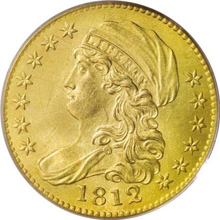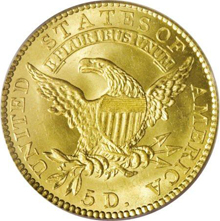 1812 $5 MS65 PCGS. Narrow 5D, Breen-6465, B. 1-A, Miller-117, R.4. While 1812 half eagles are of interest to many of today's collectors simply as the final year of this coinage type, this should be a magical date for a reason of far more significance. George Washington and his Federalist party's political agenda of mending relations with Great Britain while at the same time bolstering the young nation's Army and Navy, and fortifying cities on the Atlantic Ocean with forts capable of warding off naval attacks, had given way to an era of belt-tightening. The Democratic-Republican party of Presidents Jefferson and Madison came into office in 1801 on a wave of voter sentiment that called for reducing the national debt from the early years of maintaining a strong military. The budgets of those two presidents cut spending for defense and passed treaties that favored trade and alliance not with Great Britain but with France, the old Revolutionary War ally. Beginning in 1809, as he entered the White House, President Madison actually believed that another war with Britain could be beneficial to the United States. Tensions rose in the American capital and spread slowly up and down the Eastern Seaboard, as commercial trade with Britain slackened. A scare spread through the former Colonies as war approached.
1812 $5 MS65 PCGS. Narrow 5D, Breen-6465, B. 1-A, Miller-117, R.4. While 1812 half eagles are of interest to many of today's collectors simply as the final year of this coinage type, this should be a magical date for a reason of far more significance. George Washington and his Federalist party's political agenda of mending relations with Great Britain while at the same time bolstering the young nation's Army and Navy, and fortifying cities on the Atlantic Ocean with forts capable of warding off naval attacks, had given way to an era of belt-tightening. The Democratic-Republican party of Presidents Jefferson and Madison came into office in 1801 on a wave of voter sentiment that called for reducing the national debt from the early years of maintaining a strong military. The budgets of those two presidents cut spending for defense and passed treaties that favored trade and alliance not with Great Britain but with France, the old Revolutionary War ally. Beginning in 1809, as he entered the White House, President Madison actually believed that another war with Britain could be beneficial to the United States. Tensions rose in the American capital and spread slowly up and down the Eastern Seaboard, as commercial trade with Britain slackened. A scare spread through the former Colonies as war approached.
 The British, more savvy in warfare and in diplomacy, realized that the American military was now undermanned because of budget cuts and that none of the former American military commanders who had defeated them in the Revolutionary War remained in the Army or Navy. Furthermore, as plans for a series of coastal forts were abandoned through the first decade of the new century, Britain realized that America's cities were open to invasion. When war was declared on Great Britain by the Democratic-Republican Congress in the spring of 1812, it was not Britain but America that was threatened, it was not Britain but America that temporarily lost its greatest natural ally and commercial partner, and it was not London but Washington City (as the capital was then called) that foreign troups would invade. Shortly afterward, Redcoats burned and nearly destroyed the White House, the government itself had to seek refuge, and the War of 1812--which lasted two years and eight months, from mid-June 1812 through mid-February 1815--became, in effect, America's second war of independence. Some saw disaster looming in 1812, including Daniel Sheffey, a Virginia Federalist, who wrote: "We have considered ourselves of too much importance in the scale of nations. It led us into great errors ... we have imagined that our own destiny ... was in our own hands ..." A few citizens took action to safeguard their own welfare: As Walter Breen pointed out in his Complete Encyclopedia, a number of Mint State 1812 half eagles exist, "apparently from an old hoard." Doubtless, a scattering of the largest, newest American gold coins then being minted, the five dollar pieces, "went into hiding" as those who saw the War of 1812 coming saved their gold, accounting for today's luxurious if tiny supply of pristine pieces bearing that year's date.
The British, more savvy in warfare and in diplomacy, realized that the American military was now undermanned because of budget cuts and that none of the former American military commanders who had defeated them in the Revolutionary War remained in the Army or Navy. Furthermore, as plans for a series of coastal forts were abandoned through the first decade of the new century, Britain realized that America's cities were open to invasion. When war was declared on Great Britain by the Democratic-Republican Congress in the spring of 1812, it was not Britain but America that was threatened, it was not Britain but America that temporarily lost its greatest natural ally and commercial partner, and it was not London but Washington City (as the capital was then called) that foreign troups would invade. Shortly afterward, Redcoats burned and nearly destroyed the White House, the government itself had to seek refuge, and the War of 1812--which lasted two years and eight months, from mid-June 1812 through mid-February 1815--became, in effect, America's second war of independence. Some saw disaster looming in 1812, including Daniel Sheffey, a Virginia Federalist, who wrote: "We have considered ourselves of too much importance in the scale of nations. It led us into great errors ... we have imagined that our own destiny ... was in our own hands ..." A few citizens took action to safeguard their own welfare: As Walter Breen pointed out in his Complete Encyclopedia, a number of Mint State 1812 half eagles exist, "apparently from an old hoard." Doubtless, a scattering of the largest, newest American gold coins then being minted, the five dollar pieces, "went into hiding" as those who saw the War of 1812 coming saved their gold, accounting for today's luxurious if tiny supply of pristine pieces bearing that year's date.
The 1812 is the final year of the John Reich Capped Bust Left design and this is the scarcer of the two die pairings used this year. Although Mint records indicate a production figure of only 58,087 pieces in 1812, some experts have suggested that many of the half eagles delivered in 1813 may have actually been from 1812 dies.
The extraordinary Gem offered here is the finest Narrow 5D we have ever offered at auction and ranks high among all Mint State survivors of this sought-after issue. Early gold is difficult to locate in any grade, and it is exceptionally challenging in mint condition. Gem coins are virtually nonexistent, and there is no date in any early gold series that is "easy" to locate in high grades. The surfaces show even mint frost over each side. The devices are boldly struck, and pleasing reddish overtones complement the yellow-gold alloy. A squiggly die line is noticed on Liberty's neck and the coin is nearly defect-free, as one would expect from the grade. All in all, an unimprovable example of this popular early gold type coin. Population: 4 in 65, 0 finer (3/07). (#8112)